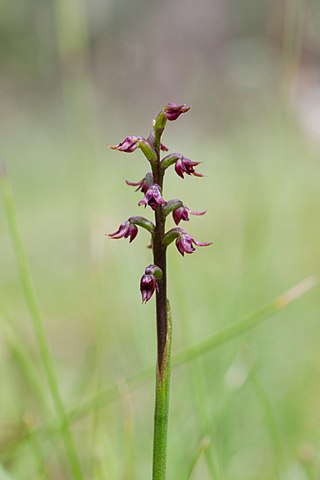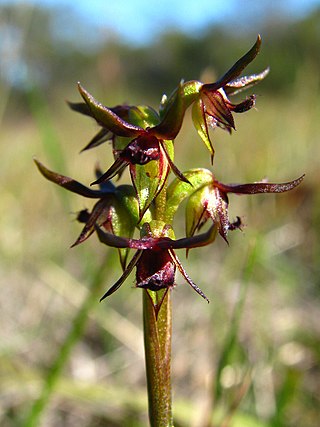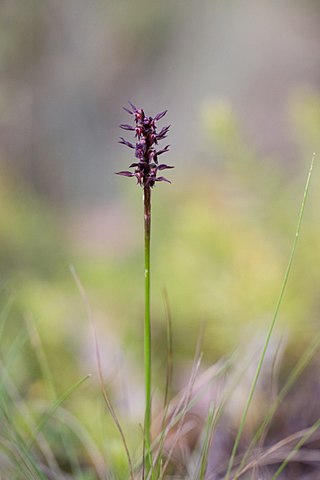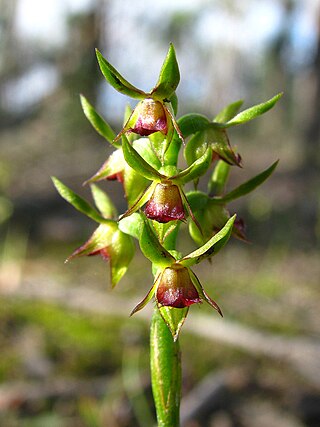
Genoplesium nudum, commonly known as the tiny midge orchid in Australia or the red midge orchid in New Zealand, is a small terrestrial orchid native to south-eastern Australia and New Zealand. It has a single thin leaf fused to the flowering stem and up to forty small, reddish-purple or green and red flowers. Australian and New Zealand authorities use the name Corunastylis nuda but Genoplesium nudum and Prasophyllum transversum are used by the World Checklist of Selected Plant Families.

Genoplesium filiforme, commonly known as the glandular midge orchid is a small terrestrial orchid endemic to the east coast of Australia. It has a single thin leaf and up to thirty greenish to purple flowers with a reddish-purple labellum. The edges of its flower parts are covered with many short glandular hairs. It is found from southern Queensland to southern New South Wales.

Genoplesium morrisii, commonly known as the bearded midge orchid and known as Corunastylis morrisii in Australia, is a small terrestrial orchid endemic to south-eastern Australia. It has a single thin leaf fused to the flowering stem and up to fifteen small, dark purplish-black or green and purple flowers.

Genoplesium archeri, commonly known as the elfin midge orchid and as Corunastylis archeri in Australia, is a small terrestrial orchid endemic to south-eastern Australia. It has a single thin leaf fused to the flowering stem and up to fifteen small, hairy, yellowish green flowers with purple stripes. It grows in a wide range of habitats in New South Wales, Victoria and Tasmania.

Genoplesium arrectum, commonly known as the erect midge orchid and as Corunastylis arrecta in Australia, is a small terrestrial orchid endemic to south-eastern Australia. It has a single thin leaf fused to the flowering stem and up to twenty small, dark purple flowers. It grows in a montane and subalpine grassland and forest in Victoria and the Australian Capital Territory.
Genoplesium littorale, commonly known as the Tuncurry midge orchid, is a species of small terrestrial orchid endemic that is endemic to New South Wales. It has a single thin leaf fused to the flowering stem and up to thirty small green flowers with a purple-brown labellum. It is only known from fewer than two thousand plants in a small area on the New South Wales North Coast and is critically endangered.
Genoplesium bishopii, commonly known as the Gibraltar Range midge orchid, is a small terrestrial orchid endemic to New South Wales. It has a single thin leaf fused to the flowering stem and up to thirty small, dark purplish red flowers. It grows in heathy forest and on the edges of swamps in the Gibraltar Range National Park.
Genoplesium capparinum, is a small terrestrial orchid endemic to Victoria. It is one of the midge orchids and has a single thin leaf fused to the flowering stem and up to twenty small, green flowers with purple markings. It is a rare species, found only in a small area in the south-east of the state.
Genoplesium cranei, commonly known as the Blackall Range midge orchid, is a small terrestrial orchid endemic to the Blackall Range in Queensland. It has a single thin leaf fused to the flowering stem and up to twenty small, green to greenish yellow flowers with reddish markings. It grows in open forest with shrubs and grasses.

Genoplesium ectopum, commonly known as the Brindabella spider orchid or ectopic midge orchid and as Corunastylis ectopa in Australia, is a small terrestrial orchid endemic to the Australian Capital Territory. It has a single thin leaf fused to the flowering stem and up to thirty five small, green and reddish purple flowers. It is only known from the Brindabella Range where it grows in Eucalyptus forest.

Corunastylis ciliata, commonly known as the fringed midge orchid, is a small terrestrial orchid endemic to southern Australia. It has a single thin leaf fused to the flowering stem and up to fifteen small, green to greenish yellow flowers with purplish markings and a reddish purple labellum. It was formerly included with Corunastylis archeri, and C. ciliata is regarded as a synonym of Genoplesium archeri by the World Checklist of Selected Plant Families. Plants in this species have fewer, more erect flowers, a less-hairy labellum and have different coloration than C. archeri.
Genoplesium firthii, commonly known as Firth's midge orchid, is a species of small terrestrial orchid endemic to Tasmania. It has a single thin leaf fused to the flowering stem and up to six small, yellowish green or reddish flowers with a red labellum. It grows in coastal heath and scrub and is currently only known from a single population of about twelve plants near Coles Bay.
Genoplesium formosum, commonly known as the Cathcart midge orchid is a small terrestrial orchid found in southern New South Wales. It has a single thin leaf and up to twenty five dark reddish purple flowers with darker lines.
Genoplesium insigne, commonly known as the dark midge orchid or Wyong midge orchid is a species of small terrestrial orchid that is endemic to New South Wales. It has a single thin leaf and up to twelve dark purple to dark reddish purple flowers. It is mostly found in heath on the Central Coast and only around fifty plants survive.
Genoplesium morinum, commonly known as the mulberry midge orchid, is a species of small terrestrial orchid that is endemic to New South Wales. It has a single thin leaf fused to the flowering stem and up to twenty crowded, dark reddish purple flowers. It has been known as "mulberries on sticks".
Genoplesium ostrinum, commonly known as the purple midge orchid, is a species of small terrestrial orchid that is endemic to New South Wales. It has a single thin leaf and up to ten dark purple flowers with darker stripes and a hairy labellum which vibrates in the slightest breeze.

Genoplesium pumilum, commonly known as the green midge orchid in Australia, and the yellow gumland leek orchid in New Zealand is a small terrestrial orchid native to south-eastern Australia and New Zealand. It has a single thin leaf fused to the flowering stem and up to twenty five green to yellowish-green flowers which sometimes have red markings. Australian and New Zealand authorities use the name Corunastylis pumila.

Genoplesium ruppii, commonly known as Rupp's midge orchid, is a species of small terrestrial orchid that is endemic to eastern Australia. It has a single thin leaf fused to the flowering stem and up to twenty five small, hairy green flowers with a purple labellum.
Genoplesium sigmoideum, commonly known as the Dave's Creek midge orchid, is a species of small terrestrial orchid that is endemic to a small area in the Lamington National Park in Queensland. It has a single thin leaf fused to the flowering stem and up to twenty dark red flowers with a hairy labellum. The species is treated as Corunastylis sigmoidea in Queensland.
Genoplesium turfosum, commonly known as the alpine midge orchid, is a small terrestrial orchid endemic to a small area in the higher parts of New South Wales. It has a single thin leaf fused to the flowering stem and up to twenty five dark purplish-red, crowded flowers with a sparsely hairy labellum.








